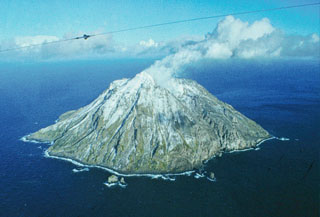Report on Chirinkotan (Russia) — April 1987
Scientific Event Alert Network Bulletin, vol. 12, no. 4 (April 1987)
Managing Editor: Lindsay McClelland.
Chirinkotan (Russia) Ash and gas columns observed
Please cite this report as:
Global Volcanism Program, 1987. Report on Chirinkotan (Russia) (McClelland, L., ed.). Scientific Event Alert Network Bulletin, 12:4. Smithsonian Institution. https://doi.org/10.5479/si.GVP.SEAN198704-290260
Chirinkotan
Russia
48.98°N, 153.48°E; summit elev. 724 m
All times are local (unless otherwise noted)
Chirinkotan was observed from the air 11, 12, and 31 October, and 2 November. A thick gas and ash column reached 700-800 m above the crater, and drifted 6-8 km downwind on 11 October. Intense gas emission occurred throughout the crater. On 12 October gas emission was less intense but a gas cloud reached 400-600 km high and was 3-4 km long despite a strong wind. By 31 October fumarolic activity had diminished significantly. On the E crater slope a few groups of large fumaroles were observed. A gas plume 200 m in diameter was 250 m high and 800-900 m long. Flank ashfall had been covered by snow that fell 12-13 October. Activity was similar on 2 November.
Geological Summary. The small, mostly unvegetated 3-km-wide island of Chirinkotan occupies the far end of an E-W volcanic chain that extends nearly 50 km W of the central part of the main Kuril Islands arc. It is the emergent summit of a volcano that rises 3000 m from the floor of the Kuril Basin. A small 1-km-wide caldera about 300-400 m deep is open to the SW. Lava flows from a cone within the breached crater reached the shore of the island. Historical eruptions have been recorded since the 18th century. Lava flows were observed by the English fur trader Captain Snow in the 1880s.
Information Contacts: G. Steinberg and B. Piskunov, Yuzhno-Sakhalinsk.

